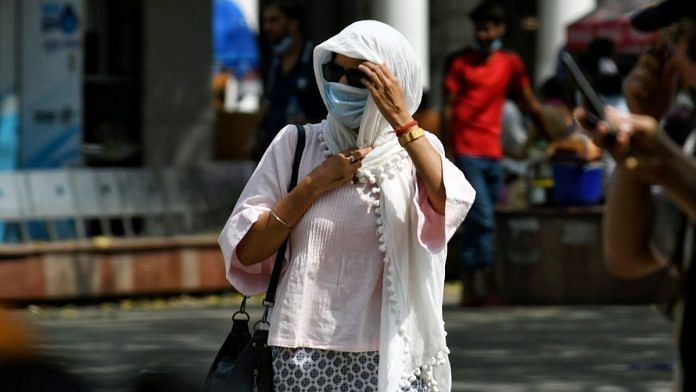New Delhi: The citizens of Delhi will likely be deprived of the usual monsoon rains for four more days to maybe a week, say meteorological experts. The capital has been experiencing high temperatures and high levels of humidity with very few signs of actual precipitation.
The India Meteorological Department (IMD) says that monsoons hit Delhi on 29 June. The organisation has also been predicting rains for the city since the beginning of the month, but, as per the IMD’s own data, the city has received only 2mm of rain during this period.
The reason, according to the experts ThePrint spoke to, is the formation of multiple, continuous low-pressure areas over the north-west and western parts of the Bay of Bengal, which are travelling in the westerly direction to Gujarat and the north-east Arabian Sea, giving North India a miss.
“The axis of monsoon is being pulled down to the south of its normal position due to these intense weather systems,” said Mahesh Palawat, vice-president, meteorology and climate change, SkyMet, a private weather forecasting service, to ThePrint. “So, until the axis of monsoon travels north, rain activities in Delhi will not commence. Intense rain activities are ruled out for next one week because there is no prominent weather system.”
However, this does not mean that the city is not seeing rain at all.
“Aya Nagar in Delhi saw a light drizzle Sunday. Even Saturday, forest areas in the city saw rain,” said R.K Jenamani, a senior weather scientist at the IMD, to ThePrint. So, he added, it’s not as if Delhi is not receiving rains. It is just receiving less rain.
“We cannot say how intense the rains will be but monsoons have already hit Delhi,” he added, reiterating IMD’s position.
Palawat, on the other hand, gave a more specific timeline for when usual monsoon activity will begin in the city. He said that the low-pressure areas over the Bay of Bengal will start degenerating and the western end of the axis of monsoon may travel north, leading to rain in north-west India, including Delhi, Punjab, Haryana and west Uttar Pradesh, by 13 or 14 July.
As of now, Odisha, Telangana, Vidarbha, Marathwada, north Maharashtra, southern Madhya Pradesh, Gujarat and southern Rajasthan are receiving good rains, he said.
Palawat also called the monsoon patterns for this year “abnormal” and said that this abnormality can be attributed to climate change.
Also read: Monsoon has turned normal, IMD says. But it really hasn’t if you see regional variations
‘Climate change or ecological disturbances’
The gradual change in the monsoon pattern, Palawat said, is one that meteorologists have been observing for the past decade or so. This means that, going forward, Delhi may not see the kind of monsoons it saw earlier, say in the 1980s or 1990s.
“The pattern this year is abnormal because usually a one-odd weather system develops over Bay of Bengal and travels in westerly direction and there’s usually a gap of a week or so between the formation of two weather systems. During this gap, the axis of monsoon travels north and gives rain over North India. But this year, we have seen there is no gap. One after another weather systems are developing,” said Palwat.
“A decade or so ago, the weather system that developed over the Bay of Bengal tended to travel north-west, up to Delhi, Haryana and Punjab. But for the past decade, most of the weather systems have been travelling in the westerly direction so it may be due to climate change or ecological disturbances,” he added.
This changed monsoon pattern also means that areas that have been traditionally dry will now see good rainfall and the ones used to receiving rainfall will see much less rainfall.
“Earlier northern states would get good rainfall and most parts of Gujarat and Rajasthan were dry. But now the central parts, particularly Madhya Pradesh, or Vidarbha and Marathwada in Maharashtra, which were usually arid regions are also receiving good rains. Moreover, Rajasthan and Gujarat, famous for dry weather, are receiving flooding rains. So, the monsoon pattern has changed in the past decade or so. In the coming years, there will be less rain in western Uttar Pradesh and Delhi,” said Palwat.
(Edited by Zinnia Ray Chaudhuri)
Also read: Another year, another deluge in Assam — why northeast floods are getting grimmer






